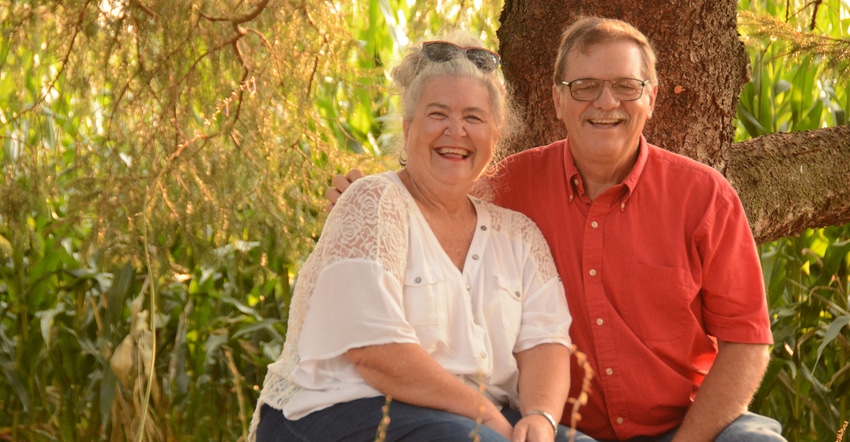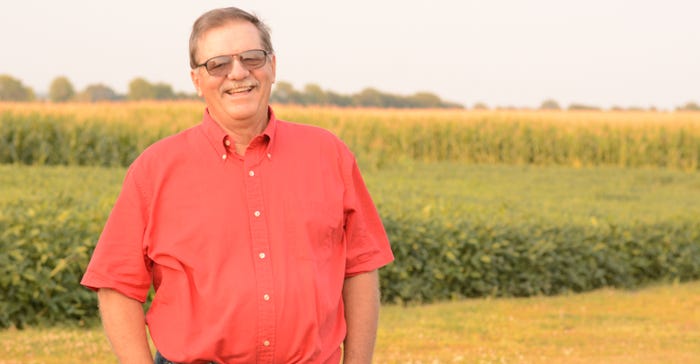
Paul Taylor learned to pivot early on, and to pivot well.
He began farming with his brother in the early ’70s near Esmond, Ill., then moved across the border to farm in Wisconsin. Fifteen years later, he earned a master’s degree and was back on the home farm. By the late ’90s, he started an equipment-sharing partnership with a neighbor.
He’s raised corn, seed corn, soybeans, lima beans, peas and sweet corn. He’s finished hogs and cattle. He’s delivered crops to seed plants and ethanol plants. And today, he’s looking to retire and transition the farm to another neighbor.
“Being a farmer has been a dream of mine since my earliest memories,” says Paul, a 2021 Prairie Farmer Master Farmer. “Striving to learn more, improve our industry and to be a steadfast member of a local community are the guiding lights that have driven me.”
Today, Paul and his wife, Barb, farm near Esmond, raising 800 acres of corn and soybeans for the local seed and ethanol markets.
Like a lot of kids raised on the farm, Paul says it’s tough to say when the green flag dropped for him. He remembers raising a strip of corn in the yard when he was 4. By the time he was 15, he sat in the banker’s office with his dad and borrowed enough money for 75 head of feeder cattle. That was 1967, and he had to sign the note, buy the feed and do the chores twice a day.
“I even made a little bit of money,” he says with a laugh.
Paul’s original plan was to farm with his brother, but he says it was harder than they anticipated. “He was 10 years older, and that was difficult.”
So he secured a bachelor’s degree from Southern Illinois University, and his parents helped him get established on a farm in Wisconsin, 85 miles northwest of the home place, where he raised corn, soybeans, hogs and feeder cattle. Paul married, raised two sons, and dove into the local and statewide farm communities, becoming president of the county pork producers, county Farm Bureau and the Wisconsin Soybean Association.
Crisis and a rebound
By the ’80s, the wheels started coming off. Paul’s father died, his brother died, and his first marriage ended. His farm neared bankruptcy. He sold off equipment and livestock, rented the farm out and went back to school, preparing for a second career in international agriculture.
And then, another surprise: the chance to come back to the home farm in 1989.
“I filled a void left by the passing of other family members, farming the land my father and I grew up on,” Paul says. He left the international ag dream behind, and after nearly two decades maturing as a young adult in another state, he started over in Illinois.
“Being home again, I began to rebuild the farm operation and equity, establish networks and reconnect with community service,” he recalls.
Part of that second career included a farm partnership with neighbor Paul Schweitzer, where they owned equipment together, shared labor and rented several hundred acres together. It was a new idea at the time, and the pair made several farm magazines as they shared their business plan.
“Quite honestly, that was a good time for both of us,” Paul recalls. “It was some of the most enjoyable years of farming when we were working together.”
The partnership lasted 15 years, until Schweitzer’s son returned to the operation in 2012. Today, Paul’s operation has evolved to primarily corn and soybeans, with one seasonal hired employee.

Paul has implemented conservation measures on both farms, including 20,000 feet of terraces in Wisconsin, and drainage tile, strip till and no-till in both places. About 10 years ago, he sold a few acres for a sow center, and captures the manure to apply on 400 acres a year.
“That’s really done good things for our soil health,” he says.
Transitions
Paul’s children work in construction, food and seed, and none are returning to the farm, so he’s begun the process to eventually transition the farm. But it’s tough to realign a farm in its entirety to one person. Still, Paul knows that’s also a part of agriculture’s story.
“It’s kind of heartbreaking to see a farm broken up. But we know that the agriculture community is full of that,” he reflects. “If you look back a hundred years, there are names in the plat book of families that didn’t have heirs to take over. So as a family, that can be heartbreaking, but it keeps the industry dynamic.”
No matter when that transition happens, a glance at the list of organizations Paul works with is a good sign he’ll stay busy. In addition to being an active board and committee member, and leader in several organizations, he’s also frequently called on to tell agriculture’s story. Lindsey Mitchell, IL Corn, says few farmer-leaders are as prepared as Paul is to speak on an issue to a legislator or to sit for an interview with media far outside of agriculture — like “National Geographic.”
So as his farm ultimately transitions, Paul will pivot with it, continuing to lend his voice and expertise to telling ag’s story, both near and far.
Living and loving together
Happiness may well be a state of mind, but it’s also reflected in a good marriage, and the Taylors’ is no exception. And while couples today meet online or through dating apps, Paul and Barb’s midlife relationship started the old-fashioned way: from an ad in the newspaper.
Some 28 years ago, Paul came across an ad for an “adventurous Christian who likes the arts and traveling.” His interest was piqued, and he and Barb spent two months talking before they met.
The rest is history, as they married two years later and will soon celebrate their 26th anniversary. Their blended family includes Paul’s two sons and Barb’s daughter.
Now retired and immersed in painting, art and gardening, Barb spent her career selling commercial and other insurance products. The pair benefited from her health insurance, and today she’s in charge of moral support on the farm, errands and business consultation.
“She’s been a really good helpmate,” Paul says.
Master at a glance
Paul Taylor
Spouse: Barbara
Children: Paul Taylor II, Amy Jao, Michael Taylor
County: DeKalb
Operation: 800 acres of corn and soybeans
Leadership: IL Corn president; National Corn Growers Association board member; DeKalb County Farm Bureau officer; DeKalb County Soil and Water Conservation District chairman; Fellowship of Christian Farmers; University of Illinois Extension County Advisory Council; Northern Illinois Alzheimer Association fundraiser; church leadership, missionary and volunteer; Wisconsin Farm Bureau county president and state resolutions committee; Wisconsin Soybean Association president; Wisconsin Rural Leadership Program graduate; Kellogg National Leadership Fellowship fellow
Nominator: IL Corn
About the Author(s)
You May Also Like






